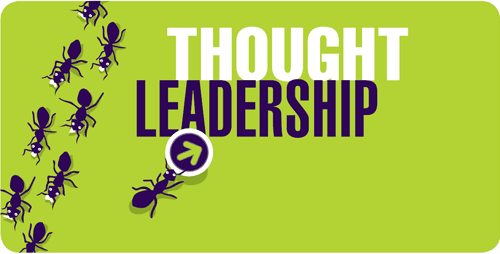Key Considerations for an Effective Thought Leadership Campaign
January 26, 2024
When it comes to content marketing, a thought leadership campaign is an initiative in its own right and intellectually completely independent from all other content marketing strategies.
The reason? Thought leaders are unique rare individuals or organizations and it is they who inform a thought leadership campaign.
What Constitutes to Thought Leadership?
Thought leadership is not an exact science and depending on who you ask what a thought leader is, you will most likely get very different answers. Forbes, however, presents two handy definitions of thought leaders:
- “A thought leader is an individual or firm that prospects, clients, referral sources, intermediaries and even competitors recognize as one of the foremost authorities in selected areas of specialization, resulting in its being the go-to individual or organization for said expertise”.
- “A thought leader is an individual or firm that significantly profits from being recognized as such”.
If we take the example of a consultant neurosurgeon who has devoted his or her life to the effective removal of Glioblastoma brain tumors over a thirty-year period with an average of 80% to 90% success rate, they would most definitely become a thought leader, and therefore, high in demand.
Over their careers, they most likely came across very challenging unique individual cases that may have required experimental treatments and surgeries that have never been done before. In addition to their education, training, and everyday experiences, these experimental treatments have allowed them to gain unique knowledge and experiences which are of great importance and value to the wider field of oncology.
So, with the above example in mind, we concur with the simple definition from dictionary.com suggesting that a thought leader is:
“a person or organization that is a recognized authority in a particular field and whose innovative ideas influence and guide others”
What is a Thought Leadership Campaign?
In simple terms, the purpose of a thought leadership campaign is to empirically build a strong, credible, industry-expert brand, and, ultimately to capitalize on your own, or your organization’s unique knowledge and expertise through robust, multichannel marketing interventions.
If we refer back to our neurosurgeon example above and assume that the neurosurgeon is employed by a large hospital chain that wants to raise its public profile.
The neurosurgeon will make the ideal thought leader that can inform a campaign by the hospital to promote their oncological departments, utilizing details from some of the effective experimental treatments carried out by the neurosurgeon, accompanied by facts and statistics that inform the public about their efficacy and success rates.

Thought Leadership vs Content Marketing
Although both are critical tools in any established organization’s digital marketing success, there are significant differences between traditional promotional content marketing and thought leadership content marketing campaigns.
- While traditional content marketing aims to inform and help solve issues, thought leadership campaigns aim to promote discussions around the expert opinions and information you promote. The idea is to get people talking about you or your organization.
- Traditional content marketing such as weekly blogging may focus on creating high-volume content published very frequently. Thought leadership focuses on high-quality, narrow-focused empirical content with a lower publishing frequency.
- Content marketing sells to your audience, while thought leadership captivates your audience.
- Content marketing promotes industry standards, whereas thought leadership campaigns have the ability to change or modify entire industry perspectives and practices.
Planning Your Thought Leadership Campaign
Thought leadership campaigns are some of the most effective ways to grab your audience’s attention and to drive revenue, but, creating a powerful campaign can be challenging. LinkedIn suggests that only 17% of B2B buyers see thought leadership content that is of exceptional quality.

It all starts with planning and following a structured approach.
When asked what some of the key considerations are in the planning stage of a major marketing campaign, former Creative Director at Ogilvy Namibia and founder of Brands By Aura Namibia, Nardus Erasmus said, “It's important to know your client and what makes their business unique. You can’t create an effective campaign without close collaboration and integration with your client”.
Founder of Brands By Aura Namibia, Nardus Erasmus
1. Thought Leadership Campaign Objectives
Embarking on a thought leadership campaign with no clear objectives is like jumping in your car and driving away with no destination. The scope and content of your campaign are determined by your objectives such as:
- Sales: It is becoming ever more challenging to sell to consumers through traditional methods such as leaflet drops, print advertising, billboards, etc. Instead of being sold to, consumers prefer finding products/services themselves and making informed buying decisions based on expert information and educational content that addresses their concerns and questions.
- Brand Building: Thought leadership campaigns are a great way to put a human face to your brand. Business equals relationships and a key objective of a good thought leadership campaign should be to connect with your audience on a personal level.
- Public Relations: Enhancing your public profile should be a key priority for all businesses, and writing your own expert content can go a long way in building credibility and trust with the public.
- Recruitment and Selection: Once you or your business is an established authority and you start publishing content around your expertise, you also generate interest in prospective talent. Driven professionals always seek out the best organizations with the best prospects of learning specialized skills.
- SEO: Search engines love quality, novel, and expert content as this improves the quality of the results they offer their customers. This means your content may be prioritized and appear more frequently.
- Building a Strong Social Presence: It goes without saying that any valuable expert content does really well on social media. People tend to like and share thought-provoking content more and you may also get a few followers, likes, and shares.
2. Identify Your Target Audience
Once you have set your objectives, you need to start thinking about your target audience. As with any effective marketing campaign, it is critical to know who you are talking to. Do some research on their age groups, how they digest information, where they get their information, their interests, and how your products/services can meet their needs.
3. Contextualize Your Campaign
Any thought leadership campaign must be situated within the wider industry context with background and insights on the issues you are addressing. For instance, if you or your company has made an advancement in science and you want to tell people about it, it is important to first do research on all the latest developments on this issue and then describe how your advancement is unique and how it benefits the industry and your target audience.
4. Conduct Competitor Research
In order to get your campaign as original as possible, you need to know what your competitors are publishing and what platforms they are using. You want your content to have a district voice that is completely independent of your competitors. Evaluate the strengths and weaknesses of their thought leadership campaigns and build your content with that in mind.
5. Clearly Define Your Expertise
This step involves thinking critically about what expertise your organization can offer that others can’t. Make a list of the key points to focus your thought leadership campaign on. Articulate in detail how specifically your knowledge, products or services help your audience with their struggles or needs.
6. Set KPIs
Start thinking about how you will measure the success of your campaign.
You can track the qualitative feedback, comments, and responses from your audience on social media, how many shares and followers you generate, conversion rates and look at how much time they spend reading your content to name a few.

Your KPIs will tell you what works well and where you can optimize your content.
7. Stick to Your Calendar
Creating an editorial calendar is critical for you to manage your thought leadership campaign. Your calendar helps you organize content deadlines, publishing dates, and SME interview and collaboration management.
Align Your Channels With Your Goals
The audience you are targeting will determine the channels you will use. For instance, if your thought leadership campaign aims to educate younger individuals on advancements you have made in the field of virtual reality, you should consider using social media posts.
If you are looking to attract new talent, you may want to publish your content on job boards or professional networking sites such as LinkedIn.
If you want to tell professionals in your field about your developments, publishing your thought leadership content in a trade publication would be ideal. If your advancements are of a significant and groundbreaking nature, you should not hesitate to approach mass media outlets such as newspapers, radio, and television.
You should also consider publishing any groundbreaking developments in academic or other journals such as the Journal of Neuroscience, for example.
Wherever you decide to publish, always ensure that all your content is available on your own blog and other platforms. These platforms incur the least cost and will drive more people to your website.
Best Practices for an Outstanding Thought Leadership Campaign
Because a thought leadership campaign is essentially evidence-based marketing, the campaign architect must ensure that it conforms to the following quality hallmarks:
- Stick to the golden rule of quality over quantity
- Keep empirical, fact-checked evidence at the core of the campaign
- Use credible sources for any research (Not Wikipedia)
- Keep it smart, informative, and creative
- Ensure the content is thought-provoking
- Keep a clearly defined marketing purpose in mind
- Tailor the content to the target audience
- Ensure the information adds value to the wider debate and industry
When developing your campaign, there are broadly four areas you should focus on
- Data: C-level decision-makers and customers are more likely to make a buying decision when you present them with data that backs up any claims you make. Everyone likes to get a new perspective and insights on existing issues and the more compelling your data, the more leads you will likely generate.
- Story: A good thought leadership campaign is not just about presenting facts and opinions with data, but rather using those data and opinions to tell a story. Here you should really consider your audience and ensure you communicate your expertise with examples and analogies to make the data clear and digestible.
- Design: Firstly, when you publish content of such a specialized nature, you want to ensure your documents, blog articles, whitepapers, and so forth are grammatically correct and follow a logical structure with clear headings and signposting. Secondly, there is no reason not to incorporate visual aids such as pictures, graphs, tables, or even infographics. People are more likely to read content with visual aids because it brings the campaign to life.
- Consistency: If you are planning a long-term thought leadership campaign, you must ensure that all the content you publish is of the same standard in terms of the quality of the information, the design, the layout, etc. You should compartmentalize the entire campaign into separate units and publish them regularly according to your calendar to build anticipation with your audience.
Erasmus says “Don’t underestimate the power of visuals. We are naturally drawn to colorful objects for a reason, they intrigue us. Where you may need to use several paragraphs to explain a simple concept in writing, a simple visual representation speaks a thousand words”.
Thought Leadership Campaign Challenges
As with any marketing campaign, you will face several challenges. The enormous interest in thought leadership has sparked an abundance of thought leadership content being created, the majority of which does not meet any sort of quality standard.
A powerful campaign must be able to navigate through the noise, adhere to the quality metrics and be accessible. If the content you publish is boring and predictable, you give your audience no reason to return for more, and you will cultivate a negative perception.

Another issue thought leadership campaigns must overcome is striking the right balance between publishing valuable information without divulging critical intellectual property which can lead to a loss of competitive commercial advantage once in the public domain.
An effective thought leadership campaign must have actionable insights that provide solutions to problems, without which your conclusions will lack enthusiasm and inspiration.
How Writing Agencies Develop Thought Leadership Campaigns
Although thought leaders are without a doubt experts in their field of study or occupation, they are not necessarily great at writing, and this is where a writing agency becomes invaluable.
Writing agencies usually employ well-educated writers from many different backgrounds and with varying levels of experience. When it comes to a thought leadership campaign, you need a diverse team of writers, not just one freelancer.
In addition to having the right balance of skills and bandwidth, a writing agency helps you to manage the entire project, which includes managing your editorial calendar, conducting all the necessary high-quality research, and interviewing the right people with the right questions to get exactly the information you need to inform your campaign.
When you as the thought leader work with a writing agency, your obligations are limited to filling in the expert knowledge gaps in their writing, saving you an enormous amount of time and effort.
A thought leadership campaign will likely have to be written across multiple mediums for many different platforms. Writing agencies are proficient in all the various mediums such as ebooks, whitepapers, books, blogs, case studies, etc. These writers also have a deep understanding of SEO best practices and can ensure your campaign appears in search results.
Finally, writing agencies are used to working to strict deadlines and can produce large volumes of proofread and edited content quickly.
Erasmus concludes, “Thought leaders are not created easily. Once you have refined your craft, you are at the embryonic stage of thought leadership. You have to keep pushing yourself to the outer limits and the unexplored regions of your craft in order to become a thought leader”.































